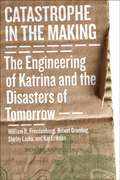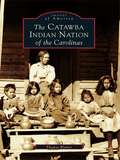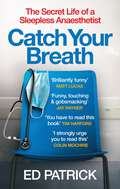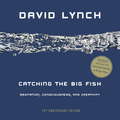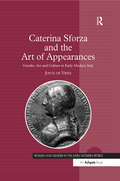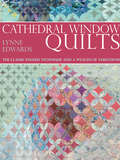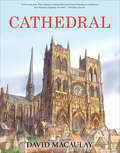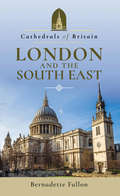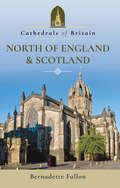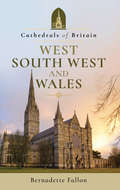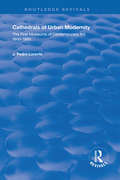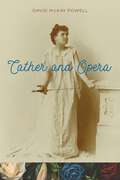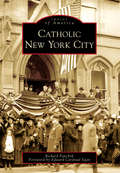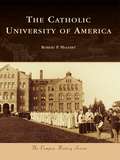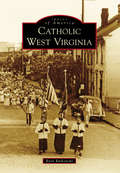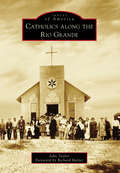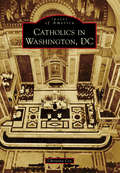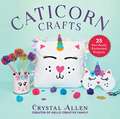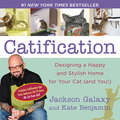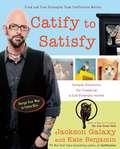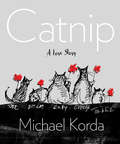- Table View
- List View
Catastrophe in the Making: The Engineering of Katrina and the Disasters of Tomorrow
by Shirley Laska William R. Freudenburg Robert B. Gramling Kai EriksonWhen houses are flattened, towns submerged, and people stranded without electricity or even food, we attribute the suffering to "natural disasters" or "acts of God." But what if they're neither? What if we, as a society, are bringing these catastrophes on ourselves? That's the provocative theory of Catastrophe in the Making, the first book to recognize Hurricane Katrina not as a "perfect storm," but a tragedy of our own making--and one that could become commonplace. The authors, one a longtime New Orleans resident, argue that breached levees and sloppy emergency response are just the most obvious examples of government failure. The true problem is more deeply rooted and insidious, and stretches far beyond the Gulf Coast. Based on the false promise of widespread prosperity, communities across the U.S. have embraced all brands of "economic development" at all costs. In Louisiana, that meant development interests turning wetlands into shipping lanes. By replacing a natural buffer against storm surges with a 75-mile long, obsolete canal that cost hundreds of millions of dollars, they guided the hurricane into the heart of New Orleans and adjacent communities. The authors reveal why, despite their geographic differences, California and Missouri are building--quite literally--toward similar destruction. Too often, the U.S. "growth machine" generates wealth for a few and misery for many. Drawing lessons from the most expensive "natural" disaster in American history, Catastrophe in the Making shows why thoughtless development comes at a price we can ill afford.
Catawba Indian Nation of the Carolinas, The (Images of America)
by Thomas BlumerThe Catawba Indians are aboriginal to South Carolina, and their pottery tradition may be traced to 2,400 B.C. When Hernando de Soto visited the Catawba Nation (then Cofitachique) in 1540, he found a sophisticated Mississippian Culture. After the founding of Charleston in 1670, the Catawba population declined. Throughout subsequent demographic stress, the Catawba supported themselves by making and peddling pottery. They have the only surviving Native American pottery tradition east of the Mississippi. Without pottery, there would be no Catawba Indian Nation today.
Catch Your Breath: The Secret Life of a Sleepless Anaesthetist
by Ed Patrick'Ed's journey is funny, sad, harrowing, hilarious... I STRONGLY URGE YOU TO READ THIS.' - Colin Mochrie A gut punch of a memoir by a doctor - and comedian - whose job is to keep people alive by putting them to sleep.Ed Patrick is an anaesthetist.Strong drugs for his patients, strong coffee for him. But it's not just sleep-giving for this anaesthetist, as he navigates emergencies, patients not breathing for themselves and living with a terrifying sense of responsibility. It's enough to leave anyone feeling numb.But don't worry, there's plenty of laughing gas to be had.'Very funny, very timely, scary in places. Ed writes with wit, insight, surprise and pathos. He is cutting his teeth in anaesthetics, taking people as close to death as you can take them, and then trying to wake them up again. And makes it funny. A joy to read.' - Phil Hammond
Catch Your Breath: The Secret Life of a Sleepless Anaesthetist
by Ed Patrick'Brilliantly funny.' - Matt Lucas'You have to read this book.' - Tim Harford'It's funny, touching and gobsmacking in equal measure. At its heart is a breathtaking account of life on the COVID frontline.' - Jay Rayner'Ed's journey is funny, sad, harrowing, hilarious... I STRONGLY URGE YOU TO READ THIS.' - Colin Mochrie'Very Funny.' - Fern BradyA gut punch of a memoir by a doctor - and comedian - whose job is to keep people alive by putting them to sleep.Ed Patrick is an anaesthetist.Strong drugs for his patients, strong coffee for him. But it's not just sleep-giving for this anaesthetist, as he navigates emergencies, patients not breathing for themselves and living with a terrifying sense of responsibility. It's enough to leave anyone feeling numb.But don't worry, there's plenty of laughing gas to be had.'Very funny, very timely, scary in places. Ed writes with wit, insight, surprise and pathos. He is cutting his teeth in anaesthetics, taking people as close to death as you can take them, and then trying to wake them up again. And makes it funny. A joy to read.' - Phil Hammond
Catch Your Breath: The Secret Life of a Sleepless Anaesthetist
by Ed Patrick***NOW INCLUDING NEW BONUS CHAPTER EXCLUSIVE TO THIS AUDIOBOOK***'It's funny, touching and gobsmacking in equal measure. At its heart is a breathtaking account of life on the COVID frontline.' - Jay Rayner'Ed's journey is funny, sad, harrowing, hilarious... I STRONGLY URGE YOU TO READ THIS.' - Colin MochrieA gut punch of a memoir by a doctor - and comedian - whose job is to keep people alive by putting them to sleep.Ed Patrick is an anaesthetist.Strong drugs for his patients, strong coffee for him. But it's not just sleep-giving for this anaesthetist, as he navigates emergencies, patients not breathing for themselves and living with a terrifying sense of responsibility. It's enough to leave anyone feeling numb.But don't worry, there's plenty of laughing gas to be had.(P)Octopus Publishing Group 2021
Catching the Big Fish
by David LynchIn this "unexpected delight,"* filmmaker David Lynch describes his personal methods of capturing and working with ideas, and the immense creative benefits he has experienced from the practice of meditation. Now in a beautiful paperback edition, David Lynch's Catching the Big Fish provides a rare window into the internationally acclaimed filmmaker's methods as an artist, his personal working style, and the immense creative benefits he has experienced from the practice of meditation. Catching the Big Fish comes as a revelation to the legion of fans who have longed to better understand Lynch's personal vision. And it is equally compelling to those who wonder how they can nurture their own creativity. Catching Ideas Ideas are like fish. If you want to catch little fish, you can stay in the shallow water. But if you want to catch the big fish, you've got to go deeper. Down deep, the fish are more powerful and more pure. They're huge and abstract. And they're very beautiful. I look for a certain kind of fish that is important to me, one that can translate to cinema. But there are all kinds of fish swimming down there. There are fish for business, fish for sports. There are fish for everything. Everything, anything that is a thing, comes up from the deepest level. Modern physics calls that level the Unified Field. The more your consciousness-your awareness-is expanded, the deeper you go toward this source, and the bigger the fish you can catch. -from Catching the Big Fish
Catching the Big Fish: Meditation, Consciousness, and Creativity
by David LynchIn this "unexpected delight,"* filmmaker David Lynch describes his personal methods of capturing and working with ideas, and the immense creative benefits he has experienced from the practice of meditation.Now in a beautiful paperback edition, David Lynch's Catching the Big Fish provides a rare window into the internationally acclaimed filmmaker's methods as an artist, his personal working style, and the immense creative benefits he has experienced from the practice of meditation.Catching the Big Fish comes as a revelation to the legion of fans who have longed to better understand Lynch's personal vision. And it is equally compelling to those who wonder how they can nurture their own creativity.Catching IdeasIdeas are like fish.If you want to catch little fish, you can stay in the shallow water. But if you want to catch the big fish, you've got to go deeper.Down deep, the fish are more powerful and more pure. They're huge and abstract. And they're very beautiful.I look for a certain kind of fish that is important to me, one that can translate to cinema. But there are all kinds of fish swimming down there. There are fish for business, fish for sports. There are fish for everything.Everything, anything that is a thing, comes up from the deepest level. Modern physics calls that level the Unified Field. The more your consciousness-your awareness-is expanded, the deeper you go toward this source, and the bigger the fish you can catch.--from Catching the Big Fish
Caterina Sforza and the Art of Appearances: Gender, Art and Culture in Early Modern Italy (Women and Gender in the Early Modern World)
by Joyce de VriesIn the first major book in four decades on Caterina Sforza (1463-1509), Joyce de Vries investigates the famous noblewoman's cultural endeavors, and explores the ways in which gender, culture, and consumption practices were central to the invention of the self in early modern Italy. Sforza commissioned elaborate artistic and architectural works, participated in splendid civic and religious rituals, and collected a dazzling array of clothing, jewelry, and household goods. By engaging in these realms of cultural production, de Vries suggests, Sforza manipulated masculine and feminine norms of behavior and effectively promoted her social and political agendas. Drawing on visual evidence, inventories, letters, and contemporary texts, de Vries offers a penetrating new interpretation of women's contributions to early modern culture. She explains the correlations between prescriptive literature and women's actions and reveals the mutability of gender roles in the princely courts. De Vries's analysis of Sforza's posthumous legend suggests that what we see as "the Renaissance" was as much a historical invention as a coherent moment in historical time.
Cathedral Window Qulting: The Classic Folded Technique and a Wealth of Variations
by Lynne EdwardsIn Cathedral Window Quilting, internationally-renowned quilt designer Lynne Edwards returns to this beautiful patchwork technique by popular demand. Lynne's uniquely creative and accessible approach brings Cathedral Window quilting up to date, capturing quilters' imaginations and inspiring them to learn and enjoy this technique and its variations.
Cathedral: The Story of Its Construction, Revised and in Full Color
by David MacaulayReaders worldwide recognize Caldecott Medal winner David Macaulay's imaginary Cathedral of Chutreaux. This critically acclaimed book has been translated into a dozen languages and remains a classic of children's literature and a touchstone for budding architects. <P><P>Cathedral's numerous awards include a prestigious Caldecott Honor and designation as a New York Times Best Illustrated Book of the Year for Macaulay's intricate pen-and-ink illustrations. Journey back to centuries long ago and visit the fictional people of twelfth-, thirteenth-, and fourteenth-century Europe whose dreams, like Cathedral, stand the test of time. <P>This title has been selected as a Common Core text exemplar (Grades 6-8, Informational Texts: Science, Mathematics, and Technical Studies).
Cathedrals of Britain
by David PepinCathedrals are awe-inspiring buildings. Most are grand medieval structures, while others appear simple and unpretentious - yet all were designed to reflect the glory of God and have a profound impact on us. As trailblazers of architectural development, each cathedral has distinct individual features - such as the powerful Norman Romanesque west towers of Durham, the unique octagonal tower at Ely, and the daring late Gothic finery and spaciousness at Gloucester. In this lavishly illustrated guide to cathedrals from Bangor to York, with profiles of Roman Catholic and Scottish cathedrals, David Pepin outlines the evolution of architectural style, each building's key features, and the ongoing story of daily worship, wide-ranging ministry, conservation, the new work of craftspeople, and the increasing numbers of pilgrims and visitors.From the Trade Paperback edition.
Cathedrals of Britain: London and the South East (Cathedrals Of Britain Ser.)
by Bernadette Fallon**Pointing persistently to heaven: A guide to UK cathedrals**Power, glory, bloodshed, prayer: cathedrals in the UK are as much about human drama as spiritual sanctuary, as much about political wrangling as religious fervour. From Christian beginnings in the Middle Ages through Reformation, Renaissance and Modernity, the great cathedrals of Britain have been both battleground and place of quiet reflection; created for the glory of God for sure, but also for the glory of men.Theres a litany of great deeds and a list of secrets tied up in our national cathedrals and all are revealed within our guides, the ideal companions to the stories behind the greatest cathedrals of all. Whether you are traveling to view the buildings themselves or being an armchair enthusiast, let us take you on a journey.**Book Two: London and the South East**Four out of six of the cathedrals in this book were created for God and the Church of Rome, five now answer to the Queen of England. And the seventh isnt in fact a cathedral at all, though youll see why it takes its place among these hallowed buildings.From tiny timber churches that grew into magnificent cathedrals, from a Catholic faith turned Protestant, the story of these cathedrals, some of the foremost in Britain, is tumultuous, awe-inspiring and splattered with violence.They count among their numbers the oldest cathedral in England and the oldest religious sites in Britain. Many were established in the glory days of cathedral building under the rule of William the Conqueror from the 11th century.But their foundations go back much earlier; to small churches, priories and monasteries. Some may have been Roman temples. Pre-dating that, its likely many were Pagan shrines and places of worship.
Cathedrals of Britain: North of England & Scotland (Cathedrals of Britain)
by Bernadette Fallon**Pointing persistently to heaven: A guide to UK cathedrals**Power, glory, bloodshed, prayer: cathedrals in the UK are as much about human drama as spiritual sanctuary, as much about political wrangling as religious fervor. From Christian beginnings in the Middle Ages through Reformation, Renaissance and Modernity, the great cathedrals of Britain have been both battleground and place of quiet reflection; created for the glory of God for sure, but also for the glory of men.Theres a litany of great deeds and a list of secrets tied up in our national cathedrals and all are revealed within our guides, the ideal companions to the stories behind the greatest cathedrals of all. Whether you are traveling to view the buildings themselves or being an armchair enthusiast, let us take you on a journey.**Book One: The North of England and Scotland**From early Celtic influences through to English Reformation and the rise of Scots Calvinism, Scotland and the north of England has had a turbulent religious history. It was once united as the Kingdom of Northumbria, from Edinburgh and Lothian right down to the Humber, incorporating the counties of Durham and York and the holy isle of Lindisfarne. Today the kingdom has been dismantled but the cathedrals, which include some of the most famous buildings in the UK, still flourish and offer their secrets for discovery.Here you will solve the mystery recently uncovered in a mass grave in the countrys oldest cathedral. Find a link to one of the UKs most famous retailers in an 11th century building. Enter inside the grand Scottish cathedral built in tribute to a 7th century Greek hermit. And go underground to discover a Saxon crypt, dating from the mid 600s.
Cathedrals of Britain: West, South West And Wales (Cathedrals of Britain)
by Bernadette Fallon**Pointing persistently to heaven: A guide to UK cathedrals**Rich, rolling countryside and historic towns, scenic coasts and picture-perfect landscapes. The west of England and Wales has many attractions, and not least of these are its cathedrals. Here youll find some of Britains finest and most awe-inspiring. From the countrys longest cathedral, at Winchester, to its smallest, at St Asaph. From the tallest spire in the country at Salisbury, to the longest Gothic stone vaulted ceiling in the world at Exeter.Youll also find the cathedral founded in the nations smallest city by the man who would become the patron saint of Wales. One of the most impressive and famous cathedral fronts in the country, decorated with one of the largest collections of medieval statues in Europe. And one of only six abbeys saved from destruction during Henry VIIIs purge of the Reformation.**Book Four: The West and South West of England and Wales**
Cathedrals of Urban Modernity: Creation of the First Museums of Contemporary Art (Routledge Revivals)
by J. Pedro LorenteFirst published in 1998, this volume explores the expanding wave of a new kind of museums of contemporary art in the nineteenth and early twentieth centuries. Lorente examines their ‘coming of age’ and the weight of their museological legacy, arguing that the establishment of great national museums of art at London and Paris radiated out, carrying their influence with it. This book emerged as part of a series on towns and cities and has a focus on London and Paris as centres of artistic innovation.
Cather and Opera
by David McKay PowellThroughout her fiction, Willa Cather mentioned forty-seven operas. References to opera appear in all but three of her twelve novels and in roughly half of her short stories. Despite a dearth of musical education, Cather produced astute writing about the genre beginning in her earliest criticism and continuing throughout her career. She counted opera stars among her close friends, and according to Edith Lewis, her companion throughout adulthood, the two women frequently visited the theater, even in the early days, when purchasing tickets to attend performances proved a financial sacrifice. Melding cultural history with thoughtful readings of her works and discussions of opera’s complex place in turn-of-the-century America, David McKay Powell’s Cather and Opera offers the first book-length study of what drew the writer so powerfully and repeatedly to the art form. With close attention to Cather’s fiction and criticism, Powell posits that at the heart of both her work and the operatic corpus dwells an innate tension between high artistic ideals and popular acceptance, often figured as a clash between compositional integrity and raw, personal emotion. Considering her connection to opera in both historical and intertextual terms, Cather and Opera investigates what operatic references mean in Cather’s writing, along with what the opera represented to her throughout her life.
Catholic New York City (Images of America)
by Richard Panchyk Edward Cardinal EganCatholic New York City celebrates the religious and cultural life f one of the largest Catholic populations in the world. The first Catholic church was founded in the 1780s, and the diocese was subsequently founded in 1808, when there were only a few priests in the entire state. The 1879 completion of the country's best-known Catholic church, St. Patrick's Cathedral, was a crowning moment in New York City's Catholic history. Between 1850 and 1900, the Catholic population of New York City grew from 200,000 to more than 1.2 million due to a tremendous influx of Irish, German, Italian, Polish, and other European immigrants. Throughout the last 200 years, the city has been home to a wide range of fascinating Catholic personalities, places, and events.
Catholic University of America, The (Campus History)
by Robert P. MaleskyThe Catholic University of America is unlike any other school in the United States. Certainly there are other universities with the same passion for excellence, and there are other highly regarded Catholic universities in the country. The Catholic University of America, however, is the only national university of the Catholic Church in the United States. Founded by U.S. bishops in 1887, the project of a national university was approved by Pope Leo XIII, and after considerable debate it was decided to put the school in the nation's capital on a hilly plot of land in Northeast Washington, D.C. Classes opened on November 13, 1889, with a distinguished faculty of eight professors. Since then the university has grown exponentially, greatly expanding the number of students, teachers, and schools. The Catholic University of America has celebrated educational triumphs, suffered fiscal crises, rejoiced in two papal visits, and earned itself a place as one of the country's leading educational institutions.
Catholic West Virginia
by Ryan RutkowskiOvercoming its tumultuous beginnings, the Roman Catholic Diocese of Wheeling-Charleston has matured into a distinguished and active voice for West Virginians. One of the most unique aspects of the diocese's 160-year history is the diversity of the landscape, culture, ethnicity, and dialect that characterizes the state's identity. From Wheeling to Beckley and Martinsburg to Parkersburg, the story of our diocese comes from the individuals who established and nurtured the Catholic faith in their local communities. Without generations of the dedicated faithful, the diocese would not have thrived. Through a variety of images, this book tells the story of the generations that continued striving to give a voice to this unique Catholic community. In addition, professional researchers and local readers alike will find this volume's rare perspective of history through the lived experience of the subjects refreshing.
Catholics along the Rio Grande (Images of America)
by John Taylor Richard MelzerIn 1540, Francisco Coronado led a band of soldiers, treasure-seekers, and Franciscan priests and friars into New Mexico, changing the lives of the Native Americans forever. In 1680, less than 100 years after the first Spanish colony imposed disease, serfdom, and zealous religious oversight on the indigenous peoples, the Pueblos rose up, forcing the Spaniards out. The uprising, known as the Pueblo Revolt, lasted for 12 years, but Catholic influence was reinvigorated following the 1692 Diego De Vargas reconquest. Over the next century, the Franciscans were gradually relegated to outlying pueblos while diocesan priests from Mexico and later from France and the United States dominated the Church's expansion in the Rio Grande Valley. Today Catholicism remains strong and vibrant in New Mexico, learning the lessons and building on the foundations from the past 500 years.
Catholics in Washington D.C. (Images of America)
by Christina CoxThe Catholic community of Washington, DC, has grown and changed dramatically since 1939, when Pope Pius XII separated the city from the Archdiocese of Baltimore. Catholics in Washington, DC preserves the passion and devotion of Catholics who had Godly visions of making new religious institutions, shrines, schools, hospitals, and churches while continuing to build on their faith. This collection of photographs does more than just highlight the achievements of famous Catholics, such as Archbishop Michael Curley of the Cathedral of St. Matthew the Apostle, Mother Teresa, Pope John Paul II, Pope Benedict XVI, Pres. John Kennedy, and Pope Francis; it illustrates the superb efforts of priests, nuns, missionaries, laypersons, and political figures who have come together with great pride to grow the Catholic Church in the nation's capital.
Caticorn Crafts: 25 Purr-fectly Enchanted Projects
by Crystal AllenGet ready for a whole lot of fun with &“purr-fectly meowgical&” unicorn kitty crafts! What&’s better than a sweet fluffy kitten? A sweet fluffy kitten with a unicorn horn! From the creator of the website Hello Creative Family comes the ultimate book of caticorn crafts. Projects include: ·Smitten Kitten Caticorn Ombre Picture Frames ·Cotton Candy Caticorn Bath Bombs ·Better Than A Ball of Yarn Rainbow Pom-Pom Pencil Toppers ·Sleepy Kitty No-Sew Sleep Masks ·Meow‑gical Unicorn Kitty Flair Pins ·And much more! With material lists, templates, step‑by‑step photos, and easy‑to‑follow instructions (along with a whole bunch of glitter, rainbows, and cat puns), this book is filled with magical projects that crafters of all ages and experience levels will enjoy! It&’s guaranteed to provide hours of enchanted fun. Keep your caticorn crafts for yourself or give them as handmade gifts to brighten someone&’s day! What are you waiting for? Let&’s get crafting!
Catification: Designing a Happy and Stylish Home for Your Cat (and You!)
by Jackson Galaxy Kate BenjaminThe star of Animal Planet's hit television series My Cat from Hell, Jackson Galaxy, shows cat owners everywhere how to make their homes both cat-friendly and chic. Cat owners know the struggles of creating living spaces that are both functional and stylish for owner and cat. Don't just go to your local pet shop and adorn your home with unattractive cat towers and kitty beds. In Catification, Jackson Galaxy, the star of Animal Planet's My Cat from Hell, and Kate Benjamin, of the popular cat design website Hauspanther.com, walk readers through a step-by-step process of designing an attractive home that is also an optimal environment for cats. This gorgeously designed, full-color book includes more than twenty fun DIY projects, from kitty beds and litter boxes to catios (cat patios) that will be sure to make readers--and their cats--purr in approval.
Catify to Satisfy
by Jackson Galaxy Kate BenjaminIn this book, Jackson Galaxy, star of Animal Planet's hit show My Cat from Hell, and Kate Benjamin, cat design wizard, show cat guardians everywhere how to use home design tricks to address everyday cat care issues. Does your feline friend like to pee everywhere but in his or her litter box? Does your kitty have a thing for your furniture that has left your beloved couch in tatters? Catify to Satisfy will show you how simple DIY design projects and hacks can help bring harmony back into your home. Featuring the amazing projects cat guardians from around the world have shared with Jackson and Kate--design strategies for solving even the most daunting kitty challenges--this book is the ultimate guide to creating a happy home for cat guardian and cat alike.From the Trade Paperback edition.
Catnip: A Love Story
by Michael KordaFrom silly to sweet, 365 cat sketches by Michael Korda, drawn with love for his wife With the imagination of a writer and the eye of an artist, Michael Korda doodled on the backs of old manuscripts in his tackroom while his wife, Margaret, was out riding. They loved and acquired cats—a habit written about previously in their book, Cat People—and the few in residence at this time would serve as inspiration for the drawings. These are no ordinary cat illustrations, though. Korda’s cats read newspapers and books; go ice skating in the small country town where they live; comfort Margaret’s horse, Monty, after a stressful vet visit; sell fried mice at the Farmer’s Market, and undertake (on paper, at least) whatever fanciful endeavors their keeper conjures up. The result is a collection of magical pieces, filled with joy, that represent a year in the life of a couple in love with one another, and certainly with their cats.
